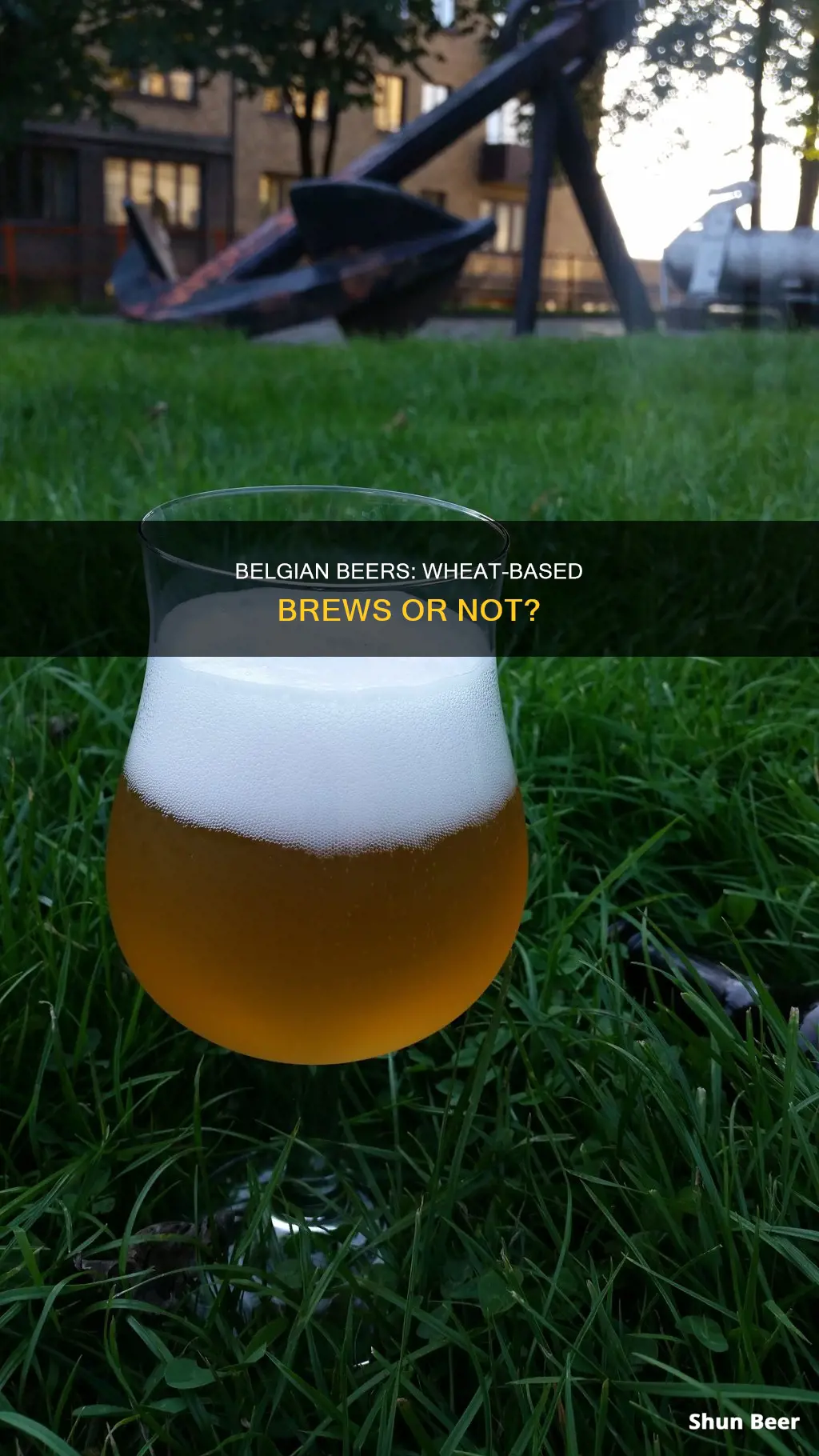
Wheat beers are top-fermented beers brewed with a large proportion of wheat relative to malted barley. Belgian wheat beers, also known as Witbier or white beer, are made with a mixture of wheat and barley, and flavoured with coriander and orange peel. They are often cloudy in appearance, with a crisp, light, and refreshing taste. Belgian wheat beers are known for their lower alcohol content compared to other beers, typically ranging from 4.5% to 7% ABV. The style originated in the Flemish part of Belgium during the Middle Ages and was revived in the 20th century, becoming an important part of the country's beer culture.
| Characteristics | Values |
|---|---|
| Origin | Flemish part of Belgium in the Middle Ages |
| Main ingredients | Wheat, barley, coriander, orange peel |
| Alcohol content | 4.5% to 7% ABV |
| Appearance | Pale, cloudy |
| Taste | Crisp, light, hint of tartness |
| Fermentation | Top-fermented |
What You'll Learn

Belgian Wheat Beer History
Belgian wheat beer, also known as white beer or witbier, is a direct descendant of beers from the medieval duchy of Brabant. It is a top-fermented beer brewed with a large proportion of wheat—approximately 50%—relative to the amount of malted barley. Before the widespread use of hops, beers were flavoured with a mixture of herbs called "gruit". During the Middle Ages, hops were introduced, and they are still used today in most Belgian White Ales.
Belgian white beers are often made with raw, unmalted wheat, and sometimes with oats. Coriander and orange peel are usually added to the brew, and other herbs may be included as well. Witbiers are typically very pale, often cloudy in appearance, and have a crisp, light, and fresh taste. They are known to be a good thirst quencher during the summer. The ABV is in the moderate range from 4.5% to 7%.
Belgian-style witbier is a style that dates back hundreds of years. It fell into relative obscurity until it was revived by Belgian brewer Pierre Celis in the 1960s. The style is currently enjoying a renaissance, especially in the American market.
Wheat Beer Allergies: Understanding the Connection and Symptoms
You may want to see also

Brewing Belgian Wheat Beer
Ingredients
Belgian Wheat Beer is made with a 50/50 distribution of unmalted wheat and malted barley. Additional grains often include oats and a melanoidin-rich malt like Munich. Coriander and orange peel are usually added to the brew, and other herbs may be included as well.
Hops
Witbier can be brewed with a wide variety of hops, but German noble hops are preferred for their gentle, clean, bittering character. The hops should be added with low flavour and aroma, and bold American-type hops should be avoided.
Spices
The addition of spices is a critical step in brewing Belgian Wheat Beer. However, it is important not to overpower the other flavours and aromas in the beer. The best way to add spices is a combination of methods: add them late in the boil and use restraint, starting with an amount that will not be overwhelming. If more spice is needed, it can always be added later by boiling some spices in a little water or adding dry spices post-fermentation. Coriander and citrus zest are commonly used spices, and it is recommended to use fresh ingredients for a brighter character.
Yeast
The type of yeast used will also impact the character of the beer. Recommended yeast types include Wyeast 3944 (Belgian Witbier) or White Labs WLP400 (Belgian Wit Ale). If using dried yeast, Brewform Blanche will produce a respectable result.
Fermentation
To begin fermentation, pitch the yeast at 68 °F (20 °C) and hold the temperature steady for the first two-thirds of fermentation. As fermentation slows, slowly raise the temperature to 72 °F (22 °C) to increase the activity of any remaining active yeast cells and ensure complete attenuation. This is crucial for achieving a crisp finish to the beer.
Carbonation
After fermentation, the beer should be carbonated to approximately 2.5 to 3 volumes of CO2.
Blue Moon Beer: Wheat or Not?
You may want to see also

Belgian Wheat Beer Glassware
Belgian wheat beer, also known as Witbier or White Ale, is a style of beer originating from the Flemish part of Belgium in the Middle Ages. It is typically brewed with a mixture of wheat and barley, and often includes spices such as coriander and orange peel. The right glassware can elevate the drinking experience of Belgian wheat beer by enhancing its flavour and aroma.
There are several types of beer glasses that can complement Belgian wheat beer:
Weizen Glass
The Weizen glass, or wheat beer glass, is specifically designed to showcase the colour of wheat beers. It has thin walls and a tall, curvaceous shape that allows for a generous pour while accommodating the thick, fluffy head that wheat beers are known for. The narrow bottom and flared top help to maintain carbonation and capture the rich aromas.
Pilsner Glass
The Pilsner glass is tall and slim, slightly wider at the mouth, and helps to showcase the sparkle, clarity, and bubbles of pilsners and other lighter beers. It typically holds less beer than a pint glass, usually around 12 to 14 ounces.
Tulip Glass
The Tulip glass, also known as the Belgian Glass, has a bulbous body and a flared lip. This shape is designed to capture the head and promote the aroma and flavour of Belgian ales and other malty, hoppy beers. The short stem facilitates swirling, further enhancing the sensory experience.
Goblet or Chalice Glass
Goblet or Chalice glasses have a large, head-retaining round bowl and a thick stem. They are often decorative and sometimes feature intricate etching or precious metal inlaying. The wide-mouth design promotes big, hearty sips and is suitable for heavy, dark beers.
Teku Stemmed Beer Glass
The Teku glass is a visually stunning craft beer glass designed by an Italian sensory expert. It features a tulip-like bowl, a thin lip, and a long stem that prevents your hand from warming the beer. The Teku glass is suitable for a wide range of beer styles, including lambics, sours, and fruit beers.
While the choice of glassware can enhance the drinking experience, it is important to note that the shape and design of beer glasses also have historical and cultural significance. For example, the "stein" glass with a hinged lid was used during the era of the Black Plague to keep flies out of the beer.
Beer and Wheat: What's the Connection?
You may want to see also

Belgian Wheat Beer Taste
Wheat beers, also known as Weißbier, Weizenbier, or Witbier, are typically light in colour, low to medium in alcohol content, and can be cloudy or clear. They are usually top-fermented ales, which means that the yeast strains used in fermentation gather at the top of the tank and prefer a warmer temperature.
Belgian-style Witbier, or "white beer", is a variety of wheat beer brewed using unmalted wheat. It is refreshing, with subtle spicy notes of coriander and orange peel. The name "Witbier" comes from the Dutch word for "white beer", referring to the beer's bright colour and thick, foamy head when properly poured. Witbiers are light and smooth on the palate, with a creamy flavour. The natural effervescence and golden colour make Witbier pleasing to the eye and the palate.
Belgian Witbiers usually have an alcohol content ranging from 4.5 to 5.5% ABV. The grain or malt bill is more rigid than other beers, with a distinctive 50/50 blend of malted and unmalted wheat. This blend gives the beer its hazy, white appearance when cold due to the suspended yeast and wheat proteins.
Belgian Witbiers are best served in tulip glasses at a temperature of 45 to 50 degrees Fahrenheit. It is recommended to chill the glass or rinse it with cold water before pouring to enhance the drinking experience.
Hefeweizen: Wheat Beer, But Different
You may want to see also

Belgian Wheat Beer ABV
Wheat beers, also known as white beers, are top-fermented beers brewed with a large proportion of wheat relative to malted barley. Belgian wheat beer, or witbier, is a direct descendant of the beers from the medieval duchy of Brabant. It is generally bottle-fermented and has a fresh taste, making it a good summer drink. Witbiers are made with an approximately 50/50 distribution of unmalted wheat and malted barley, and often include flavourings such as coriander and orange peel.
Belgian witbiers typically have an ABV of between 4.5% and 6%. For example, the Blanche De Bruxelles has an ABV of 4.5%, while the Watou's Witbier has an ABV of 5%. However, some Belgian wheat beers have a higher ABV, such as the St. Bernardus Tokyo, which has an ABV of 6%.
Belgian wheat beers are known for their refreshing taste and are popular during the summer months. The style is now also brewed by Dutch and French breweries, as well as in countries such as Canada, the United States, and Scandinavia.
Wheat Beer: What's the Deal?
You may want to see also
Frequently asked questions
Wheat beer is a top-fermented beer brewed with a large proportion of wheat relative to the amount of malted barley. Wheat beers are often referred to as \"white beers\" due to their very pale, cloudy appearance.
Belgian wheat beer, or Witbier, is a style of wheat beer that originated in the Flemish part of Belgium in the Middle Ages. It is brewed with a mixture of wheat and barley, and typically flavoured with coriander and orange peel.
Wheat beers typically have a lower percentage of alcohol than other beers. They also tend to have more fruity, tropical, and citrus flavours, and are usually lighter in colour.
Wheat beer is made like regular beer but uses a larger amount of wheat compared to malted barley when brewing. Different yeast strains are used for different styles, and Belgian Witbiers usually incorporate spices and citrus into the brewing process.
Some popular Belgian wheat beers include Hoegaarden White, St. Bernardus Wit, Blanche De Bruxelles, and Brugs White Beer.







